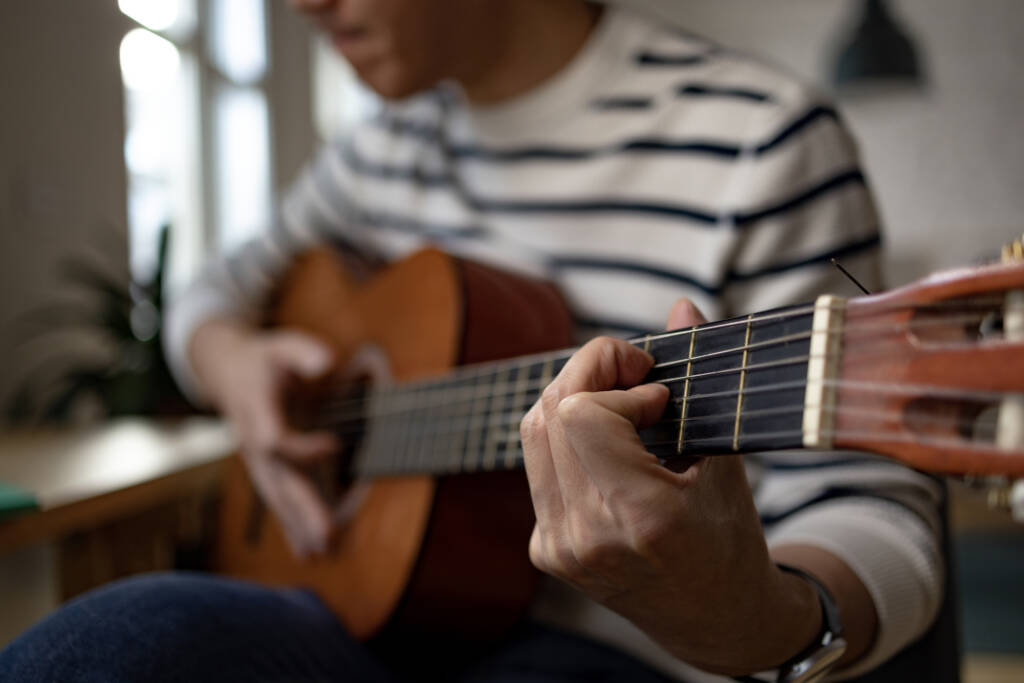
Piano 1b

Have you ever dreamed of playing the piano? Whether you love music, want to play piano or keyboard for your family and friends, or desire to be a music star, this course is a great place to start. No prior music experience is needed. You will learn the fundamentals of music and the basic skills necessary to play a wide variety of music styles. Your video presenter, Analine, will take you through each step of this journey towards becoming a skilled pianist and musician. This course can be used as a performing/fine arts credit to meet the fine art requirement for high school graduation. Let’s get started!
Major Topics and Concepts
Module 04 Expanding Your Keyboard Skills
After completing this module, you will be able to:
• Identify E, D, and C on the bass clef staff.
• Read and play ties in music.
• Understand tempo marks.
• Read and play a piece of music using the C major five-finger scale.
• Demonstrate how to practice music with hands separately.
• Read and play a piece of music in two parts (melody and accompaniment).
• Identify melodic and harmonic intervals in music.
• Play a piece of music using melodic and harmonic intervals.
Module 05 Improving Your Reading Skills
After completing this module, you will be able to:
• Define and recognize the basic elements of music: beat, rhythm, meter, pitch, dynamics, duration, and
timbre.
• Read and play music on the grand staff using a variety of time signatures, dynamics, tempos, and
intervals.
• Read and play music using the C major five-finger scale.
• Demonstrate how to play staccato.
• Read and play a piece of music in two parts (melody and accompaniment).
• Play a piece of music using melodic and harmonic intervals.
• Identify A, B, C, D, and E on the treble clef staff.
• Improvise music using the A minor five-finger scale.
• Sightread music using new notes on the treble clef staff.
• Read and play music using the A minor five-finger scale.
• Compose a piece of music using standard music notation.
Module 06 Building on Your Skills
After completing this module, you will be able to:
• Identify F and G on the treble clef staff.
• Improvise music using the C major five-finger scale in the higher octave.
• Understand new music terms and symbols: D.C. al Fine and fermata.
• Read and play a piece of music using the C major five-finger scale in the higher octave.
• Identify eighth notes by listening.
• Read and play eighth notes in music.
• Identify sharps and flats on the keyboard and on the music staff.
• Read and play music using sharps and flats.
• Read and play music using pick-up notes.
Module 07 Moving Around the Keyboard
After completing this module, you will be able to:
• Read and play music using the interval of a sixth.
• Play music using new dynamic markings: crescendo and diminuendo.
• Identify changes in dynamics in music by listening.
• Read and play music using an expanded range of notes.
• Understand phrases in music.
• Understand basic form in music (ABA and AABA).
• Play a piece of music using AABA form.
• Analyze the form of a piece of music.
• Understand the pattern of whole steps and half steps used to build a major scale.
• Identify scale degrees and function names of a major scale.
• Identify and play a C major triad.
• Understand how to play block and broken chords.
• Read and play music using the damper pedal.
• Read and play a C major scale.
• Identify and play a G dominant seventh chord.
• Identify tonic and dominant chords by listening.
• Read and play music in the key of C major.
Module 08 Encore!
After completing this module, you will be able to:
• Understand the many roles of music in society.
• Describe common styles of music.
• Identify ways people relate to music.
• Identify B, A, and G (in a lower octave) on the bass clef staff.
• Read and play a G major scale.
• Understand the concepts of key signatures and transposition in music.
• Identify and play the G major and D dominant seventh chords.
• Understand the structure of a duet and other music ensembles.
• Read and play an accompaniment to a melody in the key of G major.
• Identify F (in a lower octave) on the bass clef staff.
• Read and play an F major scale.
• Identify and play the F major and C dominant seventh chords.
• Understand a new tempo marking (ritardando).
• Read and play music in the key of F major.
• Perform music using a traditional walking bass line
Course Materials
You will need a functioning keyboard instrument (acoustic or electronic) and a way to record and submit a video performance to your instructor. Common types of acoustic keyboard instruments include upright pianos and grand pianos. The sound is produced by hammers striking the strings, which happens whenever you press a key. The keys on acoustic pianos are touch-sensitive so that when you press the keys lightly, you produce a soft sound, and when you press the keys heavily, you produce a louder sound. Standard-size pianos have 88 keys, but the number of keys may vary from piano to piano.
Acoustic pianos may require occasional tuning by a piano technician. Common types of electronic keyboard instruments include digital pianos and electric keyboards. A digital piano is designed to feel—and sound like—an acoustic piano, having the same number of touch-sensitive keys. An electric keyboard may or may not have touch-sensitive keys and usually has fewer keys and more sound effects than a digital piano.
Competencies
Expanding Keyboard Skills
Students will demonstrate an understanding of expanding their keyboard skills by defining musical elements, sight reading music on the grand staff , and by playing music with a variety of time signatures, dynamics, tempos, and intervals.
Improvising Music and Playing in Higher Octaves
Students will demonstrate an understanding of improvising music and playing music in higher octaves by explaining notations and time signatures, identifying sharps and flats, performing an improvised piece, and playing music in higher octaves.
Listening and Analyzing Musical Form
Students will demonstrate an understanding of ear training and musical form by identifying changes in chords and dynamics by listening, by explaining basic musical form, and by listening to and analyzing the form of a piece of music.
Understanding Music styles
Students will demonstrate an understanding of the role of music in society by describing common styles of music, explaining the many roles music plays, and analyzing the way people relate to music.
